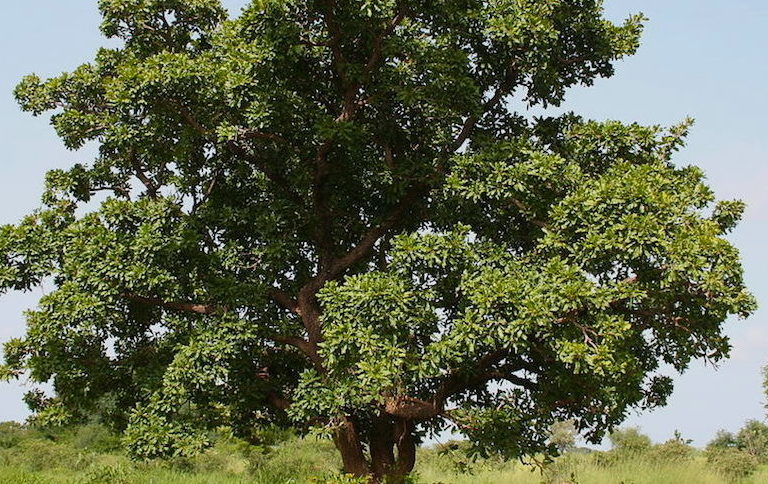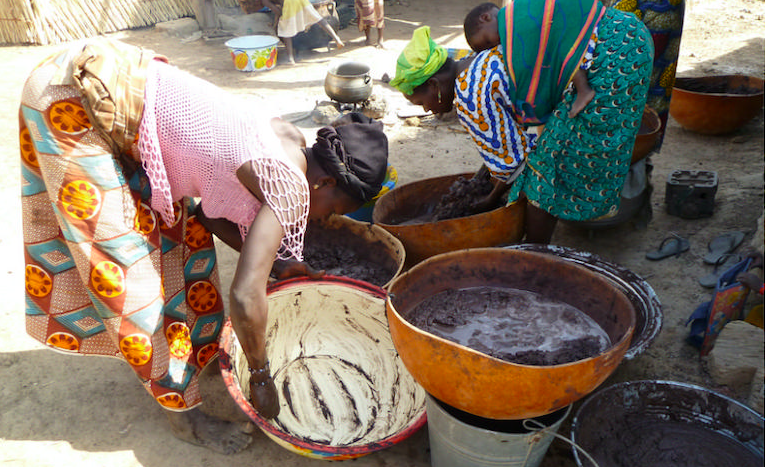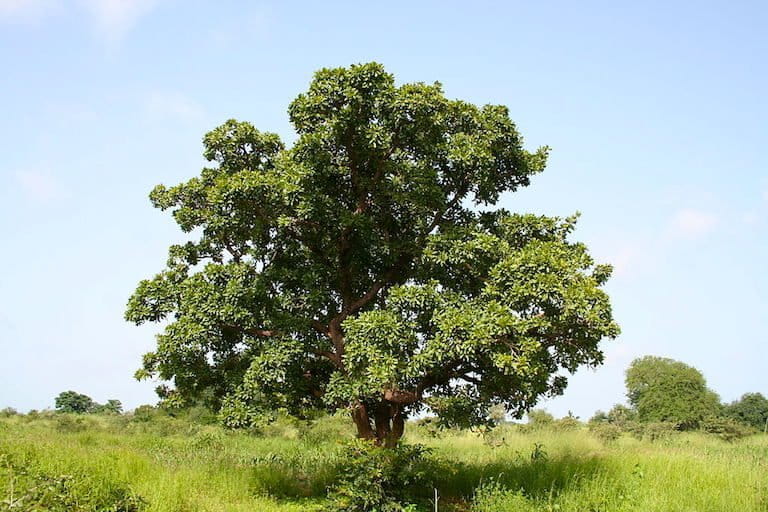
- Despite the seeming bounty of shea butter products in markets and on beauty counters globally, little known threats to shea trees are looming.
- In April, the Vice President of Ghana declared the threat to shea parklands — the agricultural landscapes dotted with shea trees in grain fields — a national priority.
- But pressures on land and gender roles are changing long-standing practices that govern land use which long favored the valuable trees.
- The views expressed are of the author, not necessarily Mongabay.
Across the African savanna belt from Senegal to Ethiopia, threats to shea trees (Vitellaria paradoxa) — the source of shea butter — have become a regional environmental concern. At the local level, land struggles disrupt social ties that have historically determined access to natural resources like shea trees, forests, and arable land. Poor farmers urgently in need of cash are cutting shea trees and reducing the fallow fields where shea regenerates. With the proliferation of shea butter products on beauty aisles globally, the growing threat to shea trees remains little known.
Cooking oil, skin moistener, hair conditioner, soap, medicine, and edible fruit are among the many uses of shea (also called karité) in the savanna belt. Rural women collect its nuts and process them to make shea butter, a significant source of income where there are few other options. The shea tree shares field space with staple food crops, providing ecosystem services of erosion control, groundwater recharge, and leaf mulch.
Standing over a recently cut shea tree in a village west of Bamako, Mali, Musa Jara responds to my questioning look by saying that in cutting the shea he is asserting his right to the land on which it grows. Cutting (or planting) a tree is a statement of secure land tenure. Yes—It’s against the traditional values and his wives are not happy with the fallen tree. His action, though, is in response to an opportunity to help his family with a one-time sale of land. The scene represents one of several threats to a savanna tree species deeply embedded in local cultures, ecologies, and economies. Pressures to sell their inherited assets — notably natural resources — force poor rural savanna residents to make decisions that threaten the trees and disrupt their social ties.

The local causes and consequences of felling shea trees can reverberate internationally: market projections predict continued growth in exports of shea nuts and butter to Europe and North America, with new markets developing in East Asia over the next 5 years. Global demand for shea butter is driven by shea butter’s value as an edible fat that can be used in chocolate, as well as in skin, hair, and other personal care products. With most butter-making in Africa’s savanna belt taking place informally outside of record-keeping, reliable production data are scarce. Clearly, though, imperiled conditions for shea trees jeopardize global supply.
With its cultural heritage, role in local cuisines, women’s income, agroecology, and growing global trade value, the loss of shea trees is alarming.
In April, the Vice President of Ghana Mahamudu Bawumia declared the threat to shea parklands—the agricultural landscapes dotted with shea trees in grain fields—a national priority. Last year, Ugandan school teacher and environmental activist Mustafa Gerima arrived in Nairobi, Kenya at the headquarters of the United Nations Environment Programme after walking over 650 kilometers from Kampala, Uganda to raise awareness of the felling of shea trees in northwestern Uganda where he lives. In Burkina Faso, during a 4-day advocacy campaign in July 2018, Korotoumou Ouédraogo spoke with local leaders in shea-growing districts of the need to protect shea trees. Although cultural taboos and laws forbid cutting, the practice has grown and is drawing more attention.
Why, with its multiple values, is shea threatened?
Local conditions differ, but the trends are clear. In Mr. Jara’s village where women pull water from wells and the houses are not on the electrical power grid, salaried residents of Bamako offer the equivalent of thousands of dollars for land. They want to build second homes outside the congested and rapidly expanding urban area. Like generations before them, Mr. Jara and his fellow villagers live on land obtained through their ancestral social ties. Most rural residents don’t own or purchase land and hold a deed. Rather, they farm and live on land that they have inherited. Customary rules and belief systems governing access to fields, forests, and trees often give priority to those descended from the earliest settlers. No real estate market existed until recently.
Due to their multiple uses, farmers have long kept shea trees in their grain fields. However, women and men farmers have different decision-making authority at the household level. Throughout the shea region, women are the primary collectors of shea nuts and producers of shea butter that is a source of their income. Men, though, assert primary decision-making on land-use and tree-cutting. If Mr. Jara sells land, ending his social ties to it, he will decide how to spend the large income. When his wives make shea butter, they decide how to use the comparatively meager income.
Pressures on land are changing long-standing practices that govern land-use. Shea trees reproduce naturally during fallows—periods when no cropping occurs. As rural population increases, the fallow period decreases as more area is used for crops. Without young trees, the shea stands grow old and eventually produce less. Efforts to produce higher yields of grain and other crops encourage mechanization with tractors and oxen-drawn plows. However, with mechanized tillage, trees in the fields can be a nuisance and occupy space where government-promoted commercial crops like cotton could grow.
The gender dimension is critical. Mechanization and land sales in urban peripheries are usually men’s domain, as are final decisions about household field use and tree removal. In Benin and Cote d’Ivoire, the increased global demand—and thus price—for cashew nuts has put cashew trees in competition with shea trees. Mango also competes with shea, as did jatropha during the biofuel bubble of 2007-8. Women benefit most directly from shea and other naturally occurring trees like néré (Parkia biglobosa) and baobab, and men from planted orchard crops like cashew, mango, and jatropha.

Throughout the region, men cut shea trees for charcoal making, a quick source of cash to pay for immediate expenses such as a sick family member, school expenses, or a debt. It was the charcoal of cut shea trees replacing the sustainable production of butter that inspired Mr. Gerima’s long walk to Nairobi.
Calls for protecting shea trees and enhancing the income generating potential of rural African women need to be heard. In January at the University of Peleforo Gon Coulibaly in Korhogo, Cote d’Ivoire, Professor Nafan Diarrassouba led a 3-day workshop on grafting shea trees. Prof. Diarrassouba’s research aims to improve shea nut yields. Such domestication of shea could further distance the tree from its traditional cultural and ecological contexts; however, it could also lead to higher nut yields in the increasingly market-integrated economies of rural African communities where the tree grows.
The Global Shea Alliance, an international non-profit organization, promotes sustainability and market opportunities. It is made up of women’s groups, retailers, and NGOs from over 30 producing and consuming countries. To increase its value, shea butter can be certified organic, fair-trade, and GMO-free. Shea butter could also potentially benefit from geographic indications that recognize women’s regional heritage techniques in butter-making. These efforts could greatly benefit the rural women producers and protect the trees.
African farmers have managed shea parklands for centuries, integrating the tree into livelihood strategies. In fact, recent archaeological evidence from Burkina Faso shows cultural use of shea for nearly 2000 years. A Bamanan proverb from Mali reveals the tree’s value: “If you start to clear trees for a field by cutting a shea, all the other tree species should be scared.” Their fear is because the shea is so valuable, that if it is cut first then surely all the other trees are doomed. No tree is as valuable as a shea! More broadly, if you destroy the most valuable thing, then everything else does not have a chance.[1]
Agrarian change with increasingly monetized values for natural resources like shea trees and the land on which they grow leads to paradoxes like that in the Jara household. When coupled with poverty, how can farmers maintain the web of social-ecological relations that created and sustained the shea agro-ecosystem? Pressures beyond the shea parklands force farmers to make improbable decisions like cutting multi-use trees. As a result, women farmers face losing a source of income and ecosystems collapse. Global industries purchasing shea nuts and butter have an opportunity and obligation to support the women at the base of the shea butter value chain.
Larry Becker is a professor of geography at Oregon State University, Corvallis, and has lived and worked in Cote d’Ivoire and Mali where he’s conducted research on farming systems, land-use change, and the rice commodity chain.
[1] N’i ye foro yiri tikè daminè si sun na, yiri tòw bèè siran. The Global Shea Alliance includes a similar version of this proverb on its website.

Shea trees are falling fast across Africa, victims of new pressures (commentary)
Source: Trends News

0 Comments